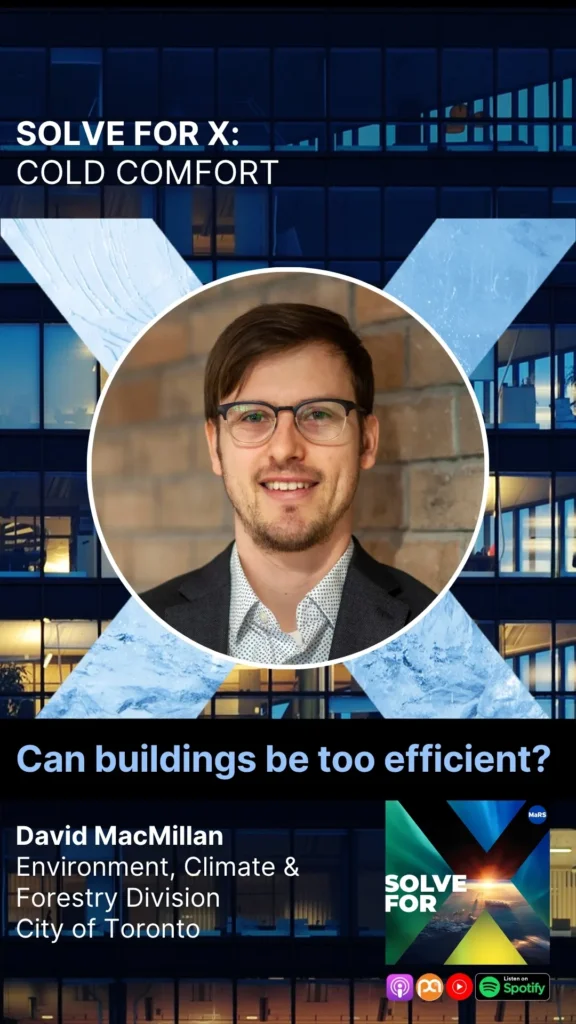Home » Solving for X – S3E11 | Are Buildings Overly Efficient?
Solving for X – S3E11 | Are Buildings Overly Efficient?

As buildings become increasingly energy-efficient, the dynamics of energy use are shifting. It is now recognized that cooling these modern structures may require more energy than heating them. This change necessitates new strategies and methods to maintain comfort for residents and office workers while mitigating the impact on the energy grid.
Experts, including David MacMillan from the City of Toronto, are investigating innovative solutions to address this challenge. The goal is to ensure that occupants remain comfortable during periods of high temperatures without overloading electrical systems. This exploration of alternatives encompasses a variety of approaches, from advanced building designs to the incorporation of sustainable technologies.
With hotter temperatures becoming more prevalent, particularly in urban areas where heat can be intensified by buildings and infrastructure, maintaining a comfortable environment is critical. The need to balance energy consumption with comfort has prompted a re-evaluation of traditional cooling methods. These discussions are part of broader conversations about sustainability and energy use in the context of climate change.
MacMillan’s involvement underscores a growing recognition among city planners and energy experts that innovative thinking and planning are essential. By examining ways to leverage passive cooling techniques, such as optimizing natural ventilation and enhancing building orientation, cities can reduce their reliance on conventional air conditioning systems. This can alleviate stress on the power grid, especially during peak demand periods when electricity use spikes.
Furthermore, smart technologies can play a significant role in this transition. Integrating sensors and building management systems can help track indoor conditions and adjust cooling accordingly, thereby improving energy efficiency. By utilizing data to inform energy use, buildings can respond dynamically to changes in occupancy and weather conditions, which can contribute to overall energy savings.
There’s also an emphasis on community engagement in these efforts. Involving residents in discussions about their comfort needs and energy use can lead to more user-centered solutions. Education on energy conservation practices and sustainable building use can empower occupants to make choices that support both their comfort and the environment.
As urban populations continue to grow, the challenge of providing adequate cooling while maintaining energy efficiency will only intensify. Multi-disciplinary partnerships among architects, engineers, urban planners, and policymakers are vital to developing long-term strategies. These collaborations can foster a holistic approach that encompasses not just individual buildings but entire neighborhoods, leading to more sustainable urban living.
In summary, as buildings evolve to become more energy-efficient, the complexities of managing indoor climates require fresh-thinking strategies. By exploring innovative solutions, cities can ensure that occupants remain comfortable while also minimizing the strain on energy resources. The work being done by experts like David MacMillan reflects a proactive approach to meet the demands of a changing environment while promoting sustainability and resilience in urban settings. Through careful planning, community involvement, and the adoption of smart technologies, cities can navigate the energy challenges of the future effectively.
MaRS Discovery District
https://www.marsdd.com/
MaRS is the world's largest urban innovation hub in Toronto that supports startups in the health, cleantech, fintech, and enterprise sectors. When MaRS opened in 2005 this concept of urban innovation was an untested theory. Today, it’s reshaping cities around the world. MaRS has been at the forefront of a wave of change that extends from Melbourne to Amsterdam and runs through San Francisco, London, Medellín, Los Angeles, Paris and New York. These global cities are now striving to create what we have in Toronto: a dense innovation district that co-locates universities, startups, corporates and investors. In this increasingly competitive landscape, scale matters more than ever – the best talent is attracted to the brightest innovation hotspots.


